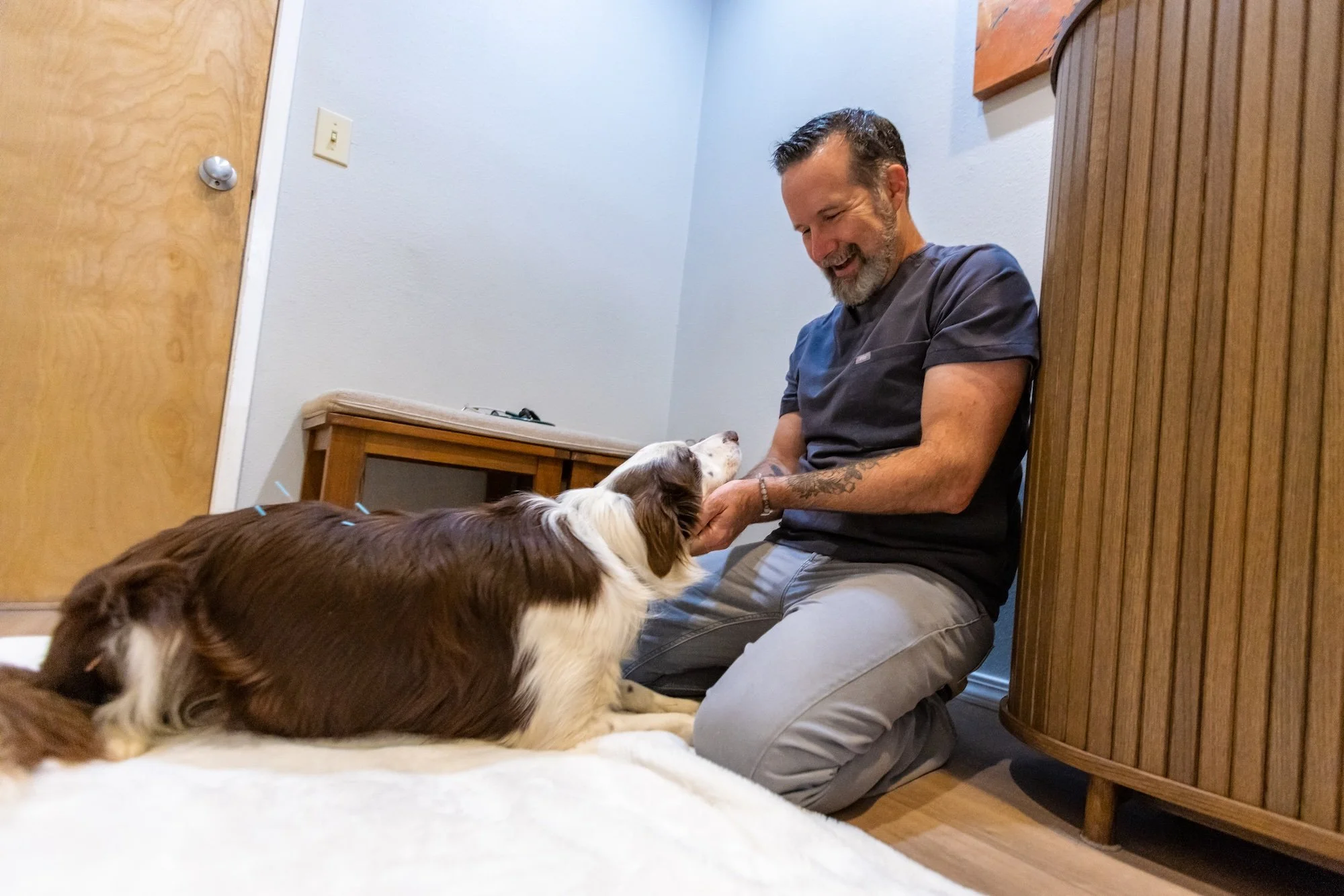The Healing Needle: How Acupuncture Joins the High Desert Veterinary Toolbox
Dr. Enyart adding acupuncture needles to Dally
We’re thrilled to share exciting news with our Central Oregon community: at High Desert Veterinary, we’re expanding our care menu to include alternative medical treatments led by Dr. Jon Enyart—a certified veterinary acupuncturist and holistic medicine expert who recently joined our team. With his background in emergency, wildlife, and integrative veterinary care, Dr. Enyart brings a fresh and thoughtful approach that blends traditional healing methods with the high-quality veterinary medicine our clients trust. More than just adding a service, this expansion reflects our commitment to offering your pet the full spectrum of wellness—where modern diagnostics, compassionate medicine, and gentle healing therapies come together.
What Acupuncture Is (And Isn’t)
At its core, acupuncture is the insertion of very fine, sterile needles into specific points on the body—called acupuncture points—to stimulate the nervous system and other organ systems, so the body can heal itself and operate more optimally. These targeted points act as gateways to the body’s natural healing mechanisms, helping promote circulation, reduce inflammation, and support organ and musculoskeletal health.
For pets, acupuncture is not a “magic fix,” but rather a therapeutic tool that supports healing in a gentle, non-pharmaceutical way. It’s important to understand that we’re not simply placing needles randomly; licensed veterinary acupuncturists select points based on each pet’s condition—whether a local problem (like a joint or muscle issue) or a systemic issue (such as digestive imbalance or anxiety). The needles are extremely fine, often painless, and many pets tolerate the sessions without sedation or significant stress. Research shows that acupuncture can stimulate the release of the body’s own endorphins and anti-inflammatory compounds, increase blood flow to tissues, and reduce muscle tension — all of which support recovery and comfort in pets.
Why It’s Valuable for Pets
Here are several ways acupuncture can benefit our four-legged companions:
Pain relief and improved mobility. Pets with arthritis, hip dysplasia, or back discomfort often respond well. Studies have shown significant improvements in pain and locomotion in dogs treated with acupuncture, alone or in combination with other therapies.
Improved circulation and tissue health. Better blood flow means more oxygen and nutrients to tissues, faster removal of metabolic waste, and more effective healing of muscle strains, soft-tissue injuries, or surgical recovery.
Support for systemic issues. Beyond joints and muscle aches, acupuncture has been used to assist pets with digestive disorders (nausea, diarrhea), respiratory issues (allergies, asthma), and even endocrine or kidney imbalances.
Low-risk and practical. Because acupuncture doesn’t rely on heavy doses of medications, it can be a great adjunctive therapy—especially for older pets or those with multiple conditions where minimizing side-effects is important.
Is Dally saying “Thank you”? I think so!
At High Desert, we view acupuncture as a partner to modern veterinary medicine—not a replacement. For example, when treating a dog post-orthopedic surgery, we may combine surgical correction + physical therapy + acupuncture to maximize comfort, speed healing, and preserve long-term mobility. This multi-modal approach often means fewer pharmaceuticals, shorter recovery times, and a better overall quality of life.
A Brief History
In case you’re wondering where the heck acupuncture comes from, here’s a bit about it. Acupuncture is steeped in a rich historical tradition. It traces its roots back thousands of years in China, where the foundation of traditional Chinese medicine (TCM) was built. Farm animals and horses were among the earliest companions to receive therapeutic needling. Over time, the practice of animal acupuncture evolved and entered Western veterinary medicine in the 20th century. The modern development of veterinary acupuncture now merges ancient wisdom with contemporary research—one reason why you’ll find peer-reviewed studies on its effects in companion animals.
How It Complements Modern Medicine
At HDV, we believe that the best outcomes come when we blend time-tested therapies with cutting-edge diagnostic and treatment options. Here’s how acupuncture fits in:
Diagnostics first: We don’t skip the basics—physical exam, imaging, lab work—so we know exactly what’s going on with your pet.
Targeted treatment planning: Once we have a diagnosis, we build a treatment plan that may include medications, surgery, physical rehabilitation, diet changes—and acupuncture.
Acupuncture as part of the continuum: We’ve seen pets respond to acupuncture quickly—sometimes noticeably after one or two sessions—and when paired with conventional care, the results often impress.
Monitoring and adjustment: Just like any therapy, acupuncture is monitored for results. We assess mobility, pain, quality of life, sleep, appetite—then adjust frequency or technique accordingly.
In Closing
If you’re looking for a way to support your pet’s comfort, mobility, and overall wellness—especially if conventional treatments alone aren’t giving the results you hoped for—acupuncture may be a valuable tool. It’s rooted in tradition, increasingly supported by research, and most importantly, it emphasizes the whole-pet—not just a symptom.
If you’d like to learn more or discuss whether acupuncture could be a good fit for your pet, feel free to reach out and book a session with Dr. Enyart. We’re here to help your dogs and cats thrive.


